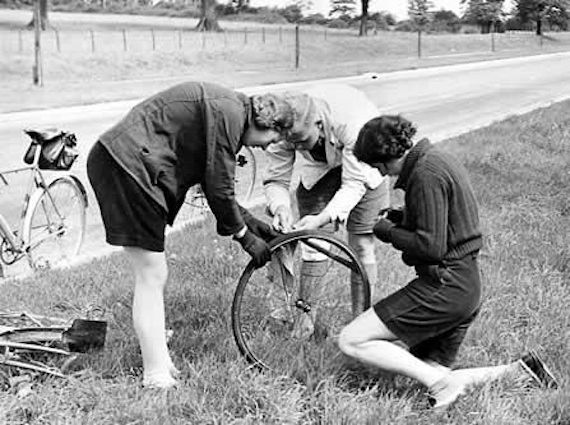On March 16, Presidio-based bike shop and team, Roaring Mouse Cycling, will be hosting an advanced class on fixing flat tires. They’ll teach tips from the pros on how to change it faster and more efficiently so you’re off and pedaling in just a few minutes.
But most of us aren't ready for pro tips yet. We need basics.
In short, how do you fix a flat by the side of the road so you don’t have to carry your bike to the shop, or flag down another bike rider to rescue you?
Chris Lane of Roaring Mouse gives us the low-down:
What tools should a basic rider carry to fix a flat tire?
Pump or CO2, spare tube, 2 tire levers, tube, patch kit (self adhesive kind), a set of allen wrenches, and enough cash for the bus.
Patch or new tube?
Tubes are so cheap these days it’s not worth patching. You don’t want to be thinking about if that patch will hold the next time you are ripping a descent do you? But always carry a patch kit as well. Recycle your tubes please; bring them to Roaring Mouse Cycles.
Can you talk us through changing a basic flat?
Shift into lowest sprocket (if you're on that kind of bike), remove the wheel. Use two levers to lift the tire bead over the edge of the rim, then slide one lever around until one bead is off rim (leave other bead on). Remove the tube, and run fingers along the inside of the tire, while visually inspecting the outside for sharp things stuck in the tire. Pump up tube just enough to give shape, then place new/patched tube in tire, start putting the bead back inside the rim, starting away from the valve. Use the levers when it gets tight, and for the last section, next to the valve, push the valve up while using the lever to lift the bead into the rim.
How do you keep your hands from getting dirty?
Cycling gloves can stay on to protect hands or keep a pair of latex exam gloves in your tire kit. They weigh nothing and take up very little space.
What’s the biggest mistake people make in changing their tire?
Not checking for what caused the flat in the first place. There’s no worse feeling than taking the time to change a tire, only to have it flat again almost immediately!
How can you help prevent a flat?
Use tires marketed as flat-resistant, and keep a high tire pressure. Take a quick moment to inspect your tires after each ride. Most debris has to work its way in, and you can catch much of it if you just look. Occasionally inspect your tires and use something sharp and metal (e.g. an awl) to remove any embedded bits of glass, gravel, or other debris.
For the pros, give us some secrets to changing it faster.
Do it at home first. A lot. Try it blindfolded, practice it a few times and watch a YouTube tutorial.
Related Articles
